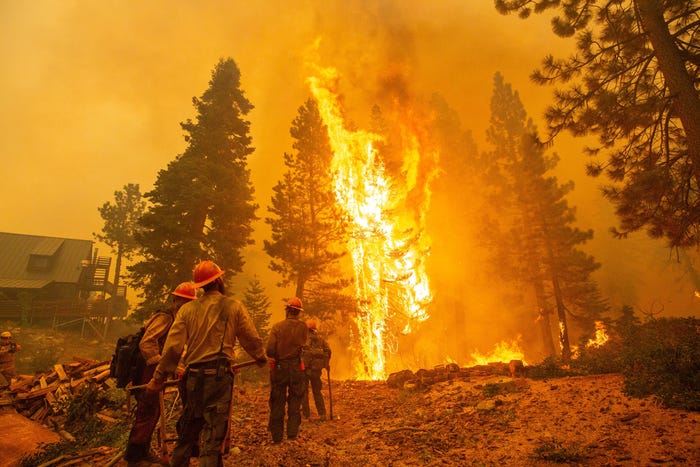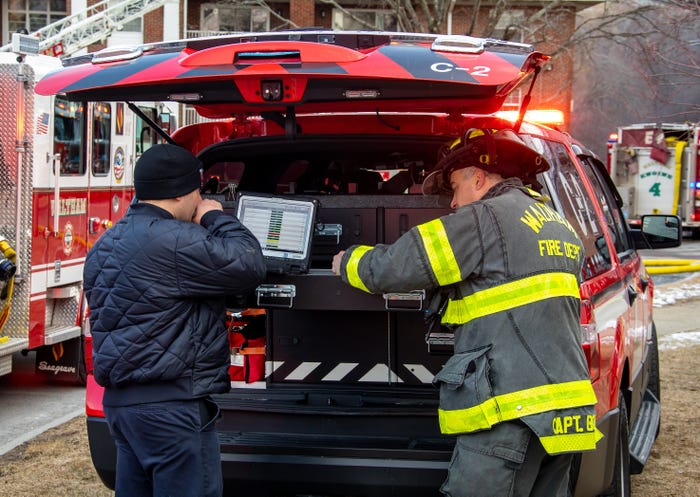Protecting the protectorsProtecting the protectors
Tracking technology keeps rescuers safer in remote, rugged terrain.
February 1, 2011
The county of Santa Barbara, Calif., contains more than 2,500 square miles of breathtaking and sometimes dangerous terrain, including rocky beaches, unblemished coastal islands teeming with wildlife, and the steep inland mountains of the Los Padres National Forest. Such picturesque wilderness, within easy driving distance of Los Angeles, attracts thousands of visitors every year. Most enjoy the county’s beauty without incident, but sometimes accidents happen. When things do go wrong, the members of the county’s search-and-rescue team are responsible for finding and rescuing missing and injured persons within the region’s backcountry.
Responding to reports of lost or hurt individuals on the county’s hundreds of trails and peaks raised safety concerns for the search-and-rescue team’s volunteer members. Although searchers are trained in the latest safety procedures, the remoteness of the terrain and the challenges of operating in small teams meant the risk was high. According to Nelson Trichler, an incident commander for the team, it was clear that some sort of radio-based GPS tracking solution was needed.
“Each searcher could carry a GPS receiver with them in the field, but that does them no good if they are incapacitated and unable to communicate their location to the dispatch operator,” Trichler said.
Previously, the team carried a consumer-type GPS receiver, which required searchers to look at the GPS to determine their location and then manually radio the location to the dispatcher at certain intervals.
So he contacted Pryme Radio Products regarding the company’s GPSMIC system, which integrates a remote speaker microphone with a GPS receiver and modem. The device is capable of sending data messages containing the user’s location data over a voice radio channel. Reports can be sent at various programmed intervals, such as when the user presses the push-to-talk button on the microphone, after a set period of time has elapsed, or when the user has moved a set distance from his or her last reported location.
The device has GPS sensitivity comparable to a high-end consumer GPS receiver, so it might not get a fix indoors, underground, in a vehicle, or in an area that is very heavily wooded or surrounded by very tall hardened buildings. If the user does not have a GPS fix, the device still will send location reports, but it sends its last known location and flags the report as “invalid” to let the dispatcher know that the rescuer may have moved since the last location fix.
Because equipment for the team is funded by a mixture of donations and grants from the Santa Barbara County Sheriff’s Department, being able to use their existing two-way radios and repeater channels was a huge plus. “This isn’t possible if we have to use separate radios or dedicated data channels,” said Neil Palt, one of the team’s communications specialists.
The SAR first deployed the GPS-enabled speaker microphone in October 2009, not in the wilderness, but in the community of Isla Vista, an unincorporated area that consists primarily of campus housing for students attending the nearby University of California–Santa Barbara. Although the area is closed to civilian motor vehicles each year on Halloween, Isla Vista attracts as many as 40,000 costumed partiers who come for one of the most notorious celebrations in the United States.
The team deployed several squads of three-to-five people, each on foot, at various points around the community. It also operated several SUVs, which primarily were used to transport sick and injured people who could not be treated on scene to areas where they could receive additional treatment, or be picked up by an ambulance and transported to local hospitals. Each team member and vehicle was outfitted with a two-way radio and the GPS speaker microphone.
Location reports from the microphones were monitored from a mobile command center at a central location within Isla Vista, with SAR members serving as dispatchers. They easily could identify from these reports the location of each team, which made it possible for them to quickly dispatch the closest team to an incident. “We were primarily interested in the GPSMICs for safety reasons” Trichler said. “But knowing where everyone was also made it possible for us to deploy faster and more efficiently.”
Computer-aided dispatch software allows the location coordinates sent by the microphone to be displayed as icons on a map. According to Scott Kuei, vice president of product development for Pryme, users can choose from several different mapping solutions. “Although we offer our own software, we support integration of the data into other third-party applications,” he said. Specifically, the company uses an extensive application programming interface that allows other software packages to parse the location data.
Santa Barbara County’s SAR chose Mytopo’s Terrain Navigator Pro because its Team Tracker module supports Pryme’s GPS speaker microphone and it has features that are uniquely suited for search-and-rescue users, including U.S. Geological Survey topographical maps, which are required when sending team members into craggy areas with sheer cliffs and other impassible features.
The team responds to an average of two incidents each week, including high-angle rock rescues, downed aircraft, swiftwater rescues and other wilderness medical emergencies. Trichler reports that each of the team’s vehicles now is outfitted with a GPS speaker microphone and that each group of team members that is deployed on foot to an incident has at least one member who carries the device. In addition to the dispatch capability in their mobile command vehicle, the team also has outfitted its headquarters with two additional base station dispatch consoles.
The technology also will greatly benefit the SAR during emergency evacuations resulting from disasters such as earthquakes and wildland fires, according to Trichler. Prior to receiving this equipment, the team was responsible for evacuating thousands of residents during the Gap, Tea and Jesusita fires in the communities surrounding Santa Barbara.
“These wildland fires move incredibly fast and often put our team members at substantial risk, so having a system showing where our members and their vehicles are is a tremendous safety and operational help,” Trichler said.
“From a safety standpoint we can alert the teams as to escape routes based on their location and which way the fire is going,” he continued. “Operationally, we can track where our teams are and have been, to document what areas have been evacuated, eliminating the potential of wasting time covering the same areas more than once.”
Trichler said that the tracking technology is essential to every aspect of their search-and-rescue operations. “We’re out there trying to ensure that missing people are safe. We need to stay safe while doing it.”
Ken Collier is the technical services manager for Pryme Radio Products.
Related Stories



